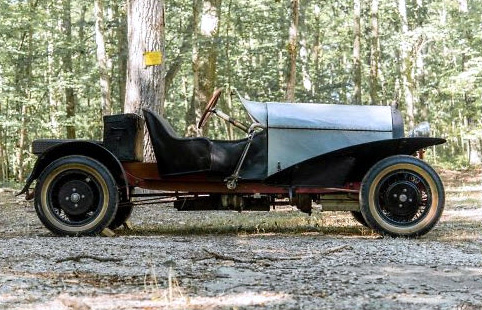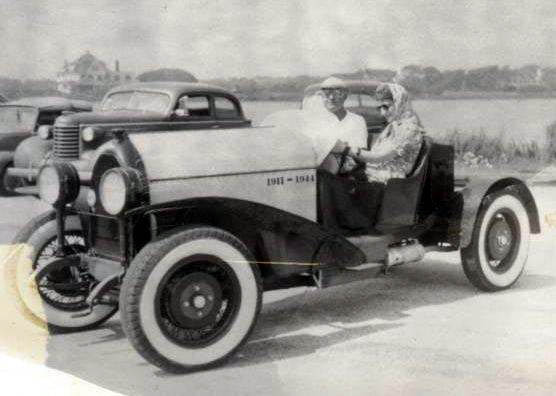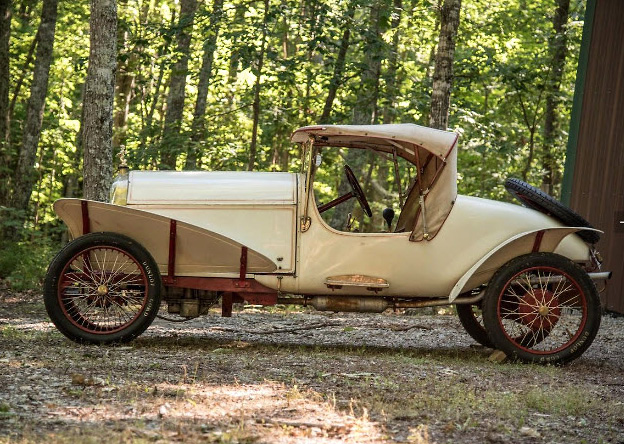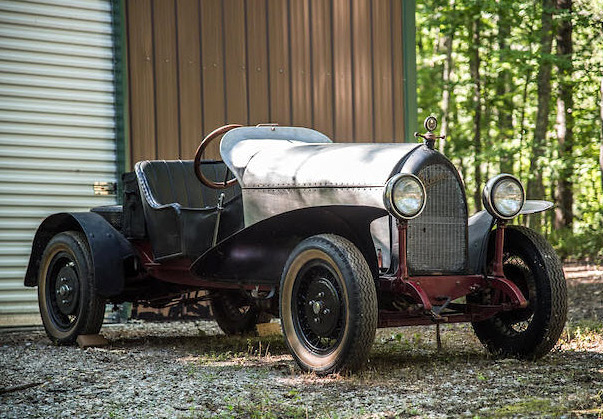Hemmings.com: Last two surviving Breese roadsters head to auction in Philadelphia

Kurt Ernst of Hemmings has reported that the two surviving Breese roasters will go to auction in Philadelphia. Articles and films on the 1911 "Breese of Paris" racer have been previously posted on VanderbiltCupRaces.com.
Enjoy,
Howard Kroplick
Hemmings.com
Last two surviving Breese roadsters head to auction in Philadelphia
Kurt Ernst
Breese Paris roadster (above). Photo courtesy of Bonhams.
As an automotive marque, Breese may be unfamiliar to even the most passionate Brass Era enthusiasts. Founded by an American engineer in Paris, France, in 1911, Breese built as many as 65 automobiles before production halted in 1912. Today, just two are known to survive, and both — the 1911 Breese Paris roadster and the 1911 Breese Paris teardrop roadster — are scheduled to cross the auction stage in Philadelphia, Pennsylvania, on October 8, part of Bonhams Simeone Foundation Automotive Museum sale.
The son of a socially prominent New York City family, Robert Potter Breese was the great-nephew of Samuel Morse, inventor of the telegraph. Educated at Harvard, Breese crossed the Atlantic to work for the Peugeot Freres Sigma Auto Company in France, employed as an assistant engineer from 1909-’11. Sensing an opportunity in the growing automobile market, Breese set off on his own to produce a lightweight sporting roadster, with the intent of building cars in France for export to the United States.
That much is certain, or at least as certain as the passage of a century-plus allows. A minimum of three Breese automobiles were produced as prototypes, including one boattail roadster (later rebodied as a simple speedster), a teardrop roadster, and a racing variant, since lost to time. The teardrop roadster — believed to be the first Breese produced — came powered by a four-cylinder flathead Fivet engine, rated at 7.5 horsepower and mated to a four-speed manual transmission, while the boattail roadster was powered by an overhead camshaft four-cylinder, possibly built by Ballot, rated at 20 hp and also mated to a four-speed transmission. The racing car followed the teardrop roadster, while the boattail roadster was said to be the final Breese prototype assembled.
There are different versions of Breese’s efforts following the construction of the prototypes. Some believe that building cars was little more than a hobby for the affluent Breese, who quickly lost interest after realizing the effort and expense involved. Others insist that Breese produced an initial batch of cars — either 61 or 62, depending upon account, which were lost at sea when the ship transporting them from Europe to America sank.
1911 Breese Paris roadster/speedster.
Regardless of the quantity ultimately manufactured, both the teardrop roadster and boattail roadster found buyers in America, specifically in the New York City area. The initial buyer of the boattail roadster isn’t documented, but in 1926 the car was acquired by a Mr. Blumberg, who allegedly spotted the Breese in a New York City garage and made the owner a generous offer for his automobile. Accompanied by his brother, Blumberg soon set off on a 5,000-mile, 18-week journey throughout the Eastern United States, remarkably suffering no mechanical issues en route.
Sometime later, the car was purchased by Robert Breese himself, who removed the original boattail bodywork in favor of the simple speedster setup the car wears today. Exact details on when and why this was done have been lost to time, but in 1946, Breese campaigned the car in a race to commemorate the Vanderbilt Cup. Removing the rear bodywork would have saved a significant amount of weight, making the car more competitive (and keeping with Breese’s minimalist philosophy), so it’s entirely possible the change was made for this race, then left alone.
Breese owned the speedster until his death in 1958, and the car remained in his family until 2001, when it was purchased by the consignor, Michael Sperrazza, whose family already owned the other surviving Breese, the teardrop roadster.
1911 Breese Paris teardrop roadster.
The teardrop roadster’s early ownership history is also unknown, but in 1927, then-owner Albert Blecher, of New York City, sold the car to musician Don Romeo. Romeo loved the Breese so much that he drove it for the next decade, until a wheel failure prompted its retirement. Romeo kept the car in his garage until 1961, when a New York City fire marshal demanded the fire hazard be removed — and promptly.
Emanuel Sperrazza purchased the car, intending to sell the mystery mobile to another collector. After meeting with Breese’s widow and learning more about the car’s history, the elder Sperrazza opted to keep the car, challenged, perhaps, at the thought of owning such a unique automobile. The restoration and reassembly of the car took Sperrazza two years, a process complicated by the absence of spare parts and reference materials. Needed parts required fabrication, but in 1963, the Breese teardrop roadster reemerged at an Antique Car Rally on Staten Island, where Sperrazza’s efforts earned him a first place award.
The Breese teardrop roadster was exhibited sparingly at other shows over the years, and circa 1990, Emanuel gifted the car to Michael, an NYPD officer and avid classic car fan. Under his ownership, it’s appeared at the Greenwich Concours d’Elegance, the Meadowbrook Concours d’Elegance, and more recently, the 2006 Hilton Head Concours d’Elegance and Motoring Festival, where it earned a Palmetto Award despite the four-plus-decades age of its restoration.
Bonhams predicts a selling price of $40,000-$60,000 for the unrestored-but-preserved Breese Paris roadster and a selling price of $100,000-$130,000 for the Breese Paris teardrop roadster.
For more on the Philadelphia Simeone Foundation Automotive Museum sale, visit Bonhams.com. For additional information on the museum, visit SimeoneMuseum.org.

Bobby Breese and his 1911 "Breese of Paris" racer. Courtesy of Walter McCarthy.
In June 1946, the Veteran Motor Car Club of America sponsored its 50th Anniversary Jubilee featuring a parade of 75 vintage cars and nine races at the Mineola Fairgrounds on Long Island. Courtesy of Walter McCarthy and the Long Island Old Car Club, the highlights of the Jubilee have been captured in this 4-minute film.
The most famous car in the Jubilee was the Old 16 Locomobile, winner of the 1908 Vanderbilt Cup Race. The racer was owned by the prominent artist Peter Helck, driven by 74-year old veteran Joe Tracy with 15-year old Jerry Helck as his mechanician. The final Jubilee race was won by Old 16 beating a 1911 "Breese of Paris" Racer driven by Bobby Breese by only six inches. This was likely the last race in which Old 16 was driven by Joe Tracy. Old 16 continued to participate in vintage races well into the early 1990s, including the VSCCA Fairmount Park (Philadelphia) Vintage Race.
Photos courtesy of Bonhams

Breese Paris teardrop roadster.

Breese Paris roadster

Comments